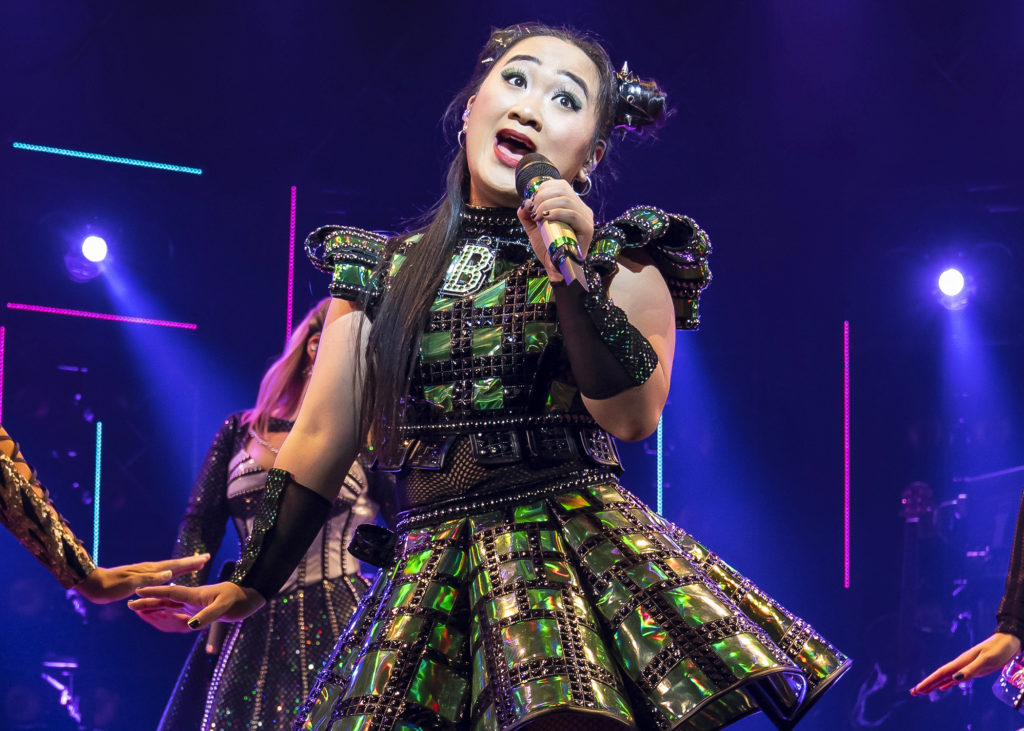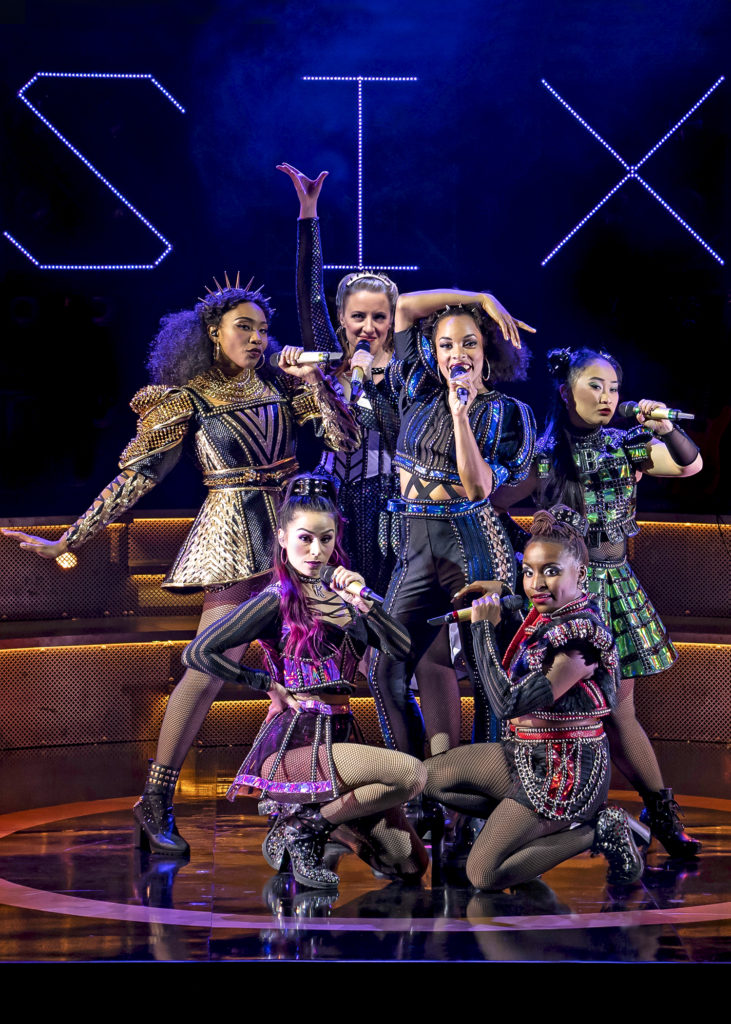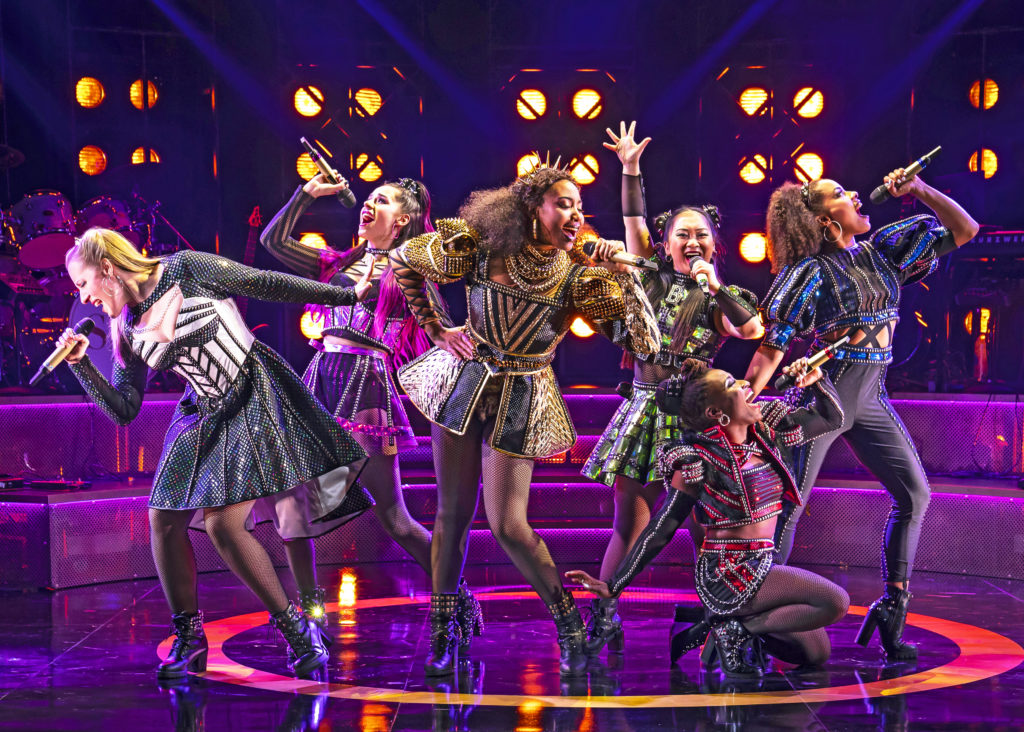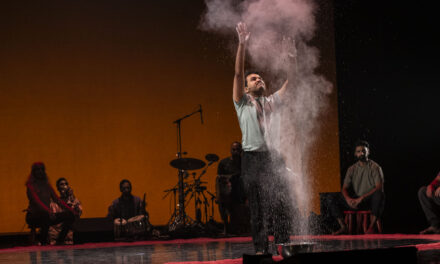A fun night out that breaks the traditional form of the musical

Review by Kyle Monda
What if the six wives of King Henry VIII formed a posthumous pop group? The musical Six is here to answer that question. Playing at the Shoctor in the Citadel Theatre, the show made its Canadian premiere on November 7th, and is running until November 24th.
The show, written by Toby Marlow and Lucy Moss and co-directed by Lucy Moss and Jamie Armitage, opens with an epic introduction of each of the Queens and their all-women backing band behind them on stage. The Queens explain that they had a miserable time married to Henry VIII, and are here to share their stories through their new music. Whichever one of them can prove they have the worst time with with the king will get to be leader of their new pop group.
After their group musical introduction, which suitably sets the tone for the soaring vocals for the rest of the show, each queen performs a solo song with the other five as backup singers/dancers in the order they were married to King Henry, with brief breaks between each to rib each other and provide some comic relief after the show’s more emotional moments. This sets a rapid pace, and the show barrels through its 80 minute run time with no intermission or major scene changes.

Catherine of Aragon, played by Adrianna Hicks, starts us off with No Way. With its confrontational lyrics, soaring vocals, and R&B beat, it wouldn’t sound out of place on Beyonce’s Lemonade. The sole Canadian member of the cast, Andrea Mascaset, was a delightfully mean Anne Boleyn, and her performance of the half-talked half-sung “Don’t Lose Ur Head” tells the arguably most famous story of the wives. Driven by a hand clap beat, the other Queens call her out for her actions throughout the song, with Boleyn singing bitterly mean lines in a sweet nursery rhyme tone, clearly inspired by Lily Allen. Six will be Mascaset’s Broadway debut, and based on this performance I am sure she will be successful in the industry.
Abby Mueller’s Jane Seymour slows down the pace a bit with a heart-wrenching power ballad, the other queens fading into the background for her literal moment in the spotlight. For the halfway point, the queens joined forces again for a wacky day-glo number “Haus of Holbein,” which sounded like what would happen if you put all the craziest Eurovision entries from the last decade into a blender.
Next was my favourite queen of the night, Anna of Cleves, enthusiastically performed by Brittney Mack. Mack might be one of the smallest of the six, but the incredible energy she brought to the stage made her performance stand above the rest. Her sassy but strong inflection of every word of “Get Down” completely sold me on the swagger of her character. Her dancing was sharp and spirited.
Katherine Howard, played by Samantha Pauly, had the most pure bubblegum pop song of the night, which crescendoed through four seemingly fun choruses to an emotionally devastating ending. Last but not least was Anna Uzele’s Catherine Parr, who brought the plot arc of the show to a close with an R&B-inspired ballad that saw all the queens join in by the end.
No spoilers, but the show ends with two final group songs and a hilariously self-aware conclusion, proving that Six doesn’t take its somewhat flimsy premise too seriously. During the last number, “Megasix,” a medley of all six individual songs remixed, audience members are invited by the queens to take “portraits,” aka photos or videos, a rare opportunity in live theatre.
Overall, watching Six feels more like you’re attending a concert than a theatre show, and that’s by design: the lighting design by Tim Deiling is set up like it would be for an arena concert, and the extremely minimal set design by Emma Bailey is essentially just risers and strips of LED lighting that light up in different shapes to change the scene. The cast uses handheld mics that become part of the choreography instead of the usual invisible sound design.

The audience was frequently invited to scream and cheer throughout the show, and I almost wished I could stand up and dance too like might be expected at a pop concert. We did end up on our feet for the “Megasix” finale, when the cast received a standing ovation, and it was well deserved.
Throughout Six, I was most impressed by the incredible voices of all six stars. I always knew professional musical theatre performers could sing. But with musical director Robereta Duchak’s bold pop music production, anyone could hear that the stars easily out-sang the classic girl groups they were emulating, all the while undertaking complicated choreography.
The songs are structured like pop, with verses leading into repeated choruses, and feature electronic beats and sounds that don’t usually make their way to the stage. While I do love show tunes, pop is definitely the soundtrack to my life, and I loved seeing a show take pop music seriously and use it to its full expressive capacity. If Six was an actual pop group, I’m sure they would be at the top of the charts.
While the focus of the show is definitely the music, the writing by newcomers Toby Marlow and Lucy Moss is brilliantly funny, and sparked more laugh-out-loud moments from the audience than I could count. Every moment is packed with well-executed puns and real life historical facts, from the lyrics of each of the songs to the frequent trash talk the ladies hurl at each other during the competition. I learned a lot about each of the queens, even if creative license has been taken with their personalities. The show is clearly aiming for a younger audience with frequent references to elements of youth culture like Tinder, making the show appropriate for older teen audiences and up.
The costume designs by Gabriella Salde are also excellent, perfectly blending contemporary fashion with Tudor-era inspiration. Each queen’s outfit was an extension of their personality, and all looked like they could stun as part of an MTV awards show performance.
In the program, creators Marlow and Moss write that their goals with the show were to allow the queens to voice their own experiences (a “herstory” rather than male-dominated history), to highlight parallels to contemporary female experiences, and to create a silly and camp show that doesn’t take itself too seriously.
I would say they succeeded in all these goals, as Six is an incredibly entertaining all-women show that does teach you something each of the women.
I wouldn’t go as far to say the show is truly making a bold political statement (Henry VIII might not actually be in the show, but few lines are about anything but him), but it is certainly a fun night out that breaks the traditional form of the musical, and comes out better for it. Six is a must-see before the production heads to Broadway next year. Don’t miss it!



Recent Comments